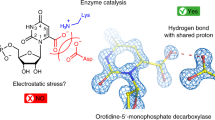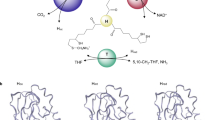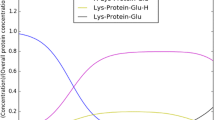Abstract
The production of gamma-aminobutyric acid (GABA) is catalyzed by two isoforms of glutamic acid decarboxylase (GAD), using pyridoxal 5′-phosphate (PLP) as the cofactor. Between the two enzymes, GAD67 accounts for normal GABA requirement, while GAD65 stays inactive until emergent demand for GABA. Recent crystal structure findings revealed that the distinct conformation of a common catalytic loop of the enzymes may account for their different functions (Fenalti et al Nat Struct Mol Biol, 14:280-286, 2007). Enlightened by their inferences, we studied the underlying reaction mechanism of the two GAD isoforms using density functional theory (DFT). A rather complete reaction pathway is identified, including nine transition state (TS) structures and 14 intermediate (IM) structures. The rate limiting step occurs early during the reaction and involves a proton transfer. In the late stage, there are two pathways that involve C4’ and Cα protonation by Tyr or Lys. Our calculations show that the reaction barriers corroborate the conjecture made by Fenalti et al.

The production of gamma-aminobutyric acid (GABA) is catalyzed by two isoforms of glutamic acid decarboxylase (GAD), using pyridoxal 5′-phosphate (PLP) as the cofactor. Between the two enzymes, GAD67 accounts for normal GABA requirement, while GAD65 stays inactive until emergent demand for GABA. Recent crystal structure findings revealed that the distinct conformation of a common catalytic loop of the enzymes may account for their different functions. In this paper, we studied the underlying reaction mechanism of the two GAD isoforms using density functional theory (DFT), aiming to provide more quantitative support. A rather complete reaction pathway with two branches in the late stage is identified for a fairly large reaction model, including nine transition state (TS) structures and 14 intermediate (IM) structures. The different transition barriers of two late reaction pathways may explain the distinct functions of the two GAD isoforms. The results not only corroborate the experimental conjectures, but also help to enrich our understanding of the working principles of the two GAD isoforms








Similar content being viewed by others
References
Metzler DE (2001) Biochemistry: the chemical reactions of living cells, 2nd ed, Vol 1. Academic, San Diego
Zempleni J, Rucker RB, Suttie JW, McCormick DB (2007) Handbook of vitamins, 4th ed. CRC, New York
Christen P, Mehta PK (2001) Chem Rec 1:436–447
Dunathan HC (1966) Proc Natl Acad Sci USA 55:712–716
Eliot AC, Kirsch JF (2004) Annu Rev Biochem 73:383–415
Porter TG, Spink DC, Martin SB, Martin DL (1985) Biochem J 231:705–712
Battaglioli G, Liu H, Martin DL (2003) J Neurochem 86:879–887
Fenalti G, Law RHP, Buckle AM, Langendorf C, Tuck K, Rosado CJ, Faux NG, Mahmood K, Hampe CS, Banga JP, Wilce M, Schmidberger J, Rossjohn J, El-Kabbani O, Pike RN, Smith AI, Mackay IR, Rowley MJ, Whisstock JC (2007) Nat Struct Mol Biol 14:280–286
Benkovic SJ, Hammes-Schiffer S (2003) Science 301:1196–1202
Garcia-Viloca M, Gao J, Karplus M, Truhlar DG (2011) Science 303:186–195
Schramm VL (2005) Arch Biochem Biophys 433:13–26
Gonzalez C, Schlegel HB (1989) J Chem Phys 90:2154–2161
Gonzalez C, Schlegel HB (1990) J Phys Chem 94:5523–5527
Himo F (2005) Theor Chem Acc 116:232–240
Siegbahn PEM, Himo F (2011) Wiley Interdiscip Rev Comput Mol Sci 1:323–336
Warshel A, Levitt M (1976) J Mol Biol 103:227–249
Field MJ, Bash PA, Karplus MJ (1990) J Comput Chem 11:700–733
Senn HM, Thiel W (2009) Angew Chem Int Ed 48:1198–1229
Frisch MJ, Trucks GW, Schlegel HB, Scuseria GE, Robb MA, Cheeseman JR, Montgomery JA Jr, Vreven T, Kudin KN, Burant JC, Millam JM, Iyengar SS, Tomasi J, Barone V, Mennucci B, Cossi M, Scalmani G, Rega N, Petersson GA, Nakatsuji H, Hada M, Ehara M, Toyota K, Fukuda R, Hasegawa J, Ishida M, Nakajima T, Honda Y, Kitao O, Nakai H, Klene M, Li X, Knox JE, Hratchian HP, Cross JB, Bakken V, Adamo C, Jaramillo J, Gomperts R, Stratmann RE, Yazyev O, Austin AJ, Cammi R, Pomelli C, Ochterski JW, Ayala PY, Morokuma K, Voth GA, Salvador P, Dannenberg JJ, Zakrzewski VG, Dapprich S, Daniels AD, Strain MC, Farkas O, Malick DK, Rabuck AD, Raghavachari K, Foresman JB, Ortiz JV, Cui Q, Baboul AG, Clifford S, Cioslowski J, Stefanov BB, Liu G, Liashenko A, Piskorz P, Komaromi I, Martin RL, Fox DJ, Keith T, Al-Laham MA, Peng CY, Nanayakkara A, Frisch MJ, Trucks GW, Schlegel HB, Scuseria GE, Robb MA, Cheeseman JR, Montgomery JA Jr, Vreven T, Kudin KN, Burant JC, Millam JM, Iyengar SS, Tomasi J, Barone V, Mennucci B, Cossi M, Scalmani G, Rega N, Petersson GA, Nakatsuji H, Hada M, Ehara M, Toyota K, Fukuda R, Hasegawa J, Ishida M, Nakajima T, Honda Y, Kitao O, Nakai H, Klene M, Li X, Knox JE, Hratchian HP, Cross JB, Bakken V, Adamo C, Jaramillo J, Gomperts R, Stratmann RE, Yazyev O, Austin AJ, Cammi R, Pomelli C, Ochterski JW, Ayala PY, Morokuma K, Voth GA, Salvador P, Dannenberg JJ, Zakrzewski VG, Dapprich S, Daniels AD, Strain MC, Farkas O, Malick DK, Rabuck AD, Raghavachari K, Foresman JB, Ortiz JV, Cui Q, Baboul AG, Clifford S, Cioslowski J, Stefanov BB, Liu G, Liashenko A, Piskorz P, Komaromi I, Martin RL, Fox DJ, Keith T, Al-Laham MA, Peng CY, Nanayakkara A, Challacombe M, Gill PMW, Johnson B, Chen W, Wong MW, Gonzalez C, Pople JA (2004) Gaussian03. Gaussian Inc, Wallingford
Lee C, Yang W, Parr RG (1988) Phys Rev B 37:785–789
Becke AD (1993) J Chem Phys 98:5648–5652
Song G, Su Y, Periana RA, Crabtree RH, Han K, Zhang H, Li X (2010) Angew Chem Int Ed 49:912–917
Yang X, Hall MB (2010) J Am Chem Soc 132:120–130
Acknowledgments
We would like to thank the support from National Natural Science Foundation of China (Grant No. 21073108), Ministry of Education of China (Grant No. 20090131120020) and Independent Innovation Foundation of Shandong University (Grant No. 2012TS006).
Author information
Authors and Affiliations
Corresponding author
Electronic supplementary material
Below is the link to the electronic supplementary material.
ESM 1
(DOC 5855 kb)
Rights and permissions
About this article
Cite this article
Wang, C., Zhu, R., Sun, H. et al. Quantum chemistry studies of the catalysis mechanism differences between the two isoforms of glutamic acid decarboxylase. J Mol Model 19, 705–714 (2013). https://doi.org/10.1007/s00894-012-1594-x
Received:
Accepted:
Published:
Issue Date:
DOI: https://doi.org/10.1007/s00894-012-1594-x




